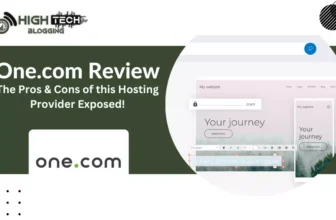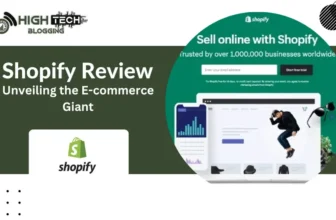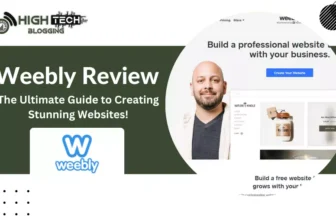Webflow Web Builder Review: Webflow is a responsive website builder that has attracted a lot of attention. But is it really any good, who is it designed for, and how much does it cost? We’re going to answer all these questions and more – but first, let’s start with the basics.
A website builder is an online platform that allows anyone to create their own website, without having to use code.
A few years ago, web developers used traditional platforms like WordPress and Drupal to create websites for their clients. Today, however, website builders like Wix, Weebly and Squarespace have opened up website creation to everyone.
Given Webflow’s clear credentials, we thought we’d take a look at it and see what all the fuss is about.
Webflow sits somewhere between traditional and modern. It’s a website builder, but it carries a level of customization and power normally reserved for WordPress.
For this reason, Webflow tends to be used by web designers. It is ideal for users who don’t want to bother with all the coding, but need a platform that is fully customizable.
Table of Contents
Webflow Web Builder Review: Is This the Ultimate Web Design Platform?
Pros & Cons of Webflow
Pros
Cons
Ease of Use
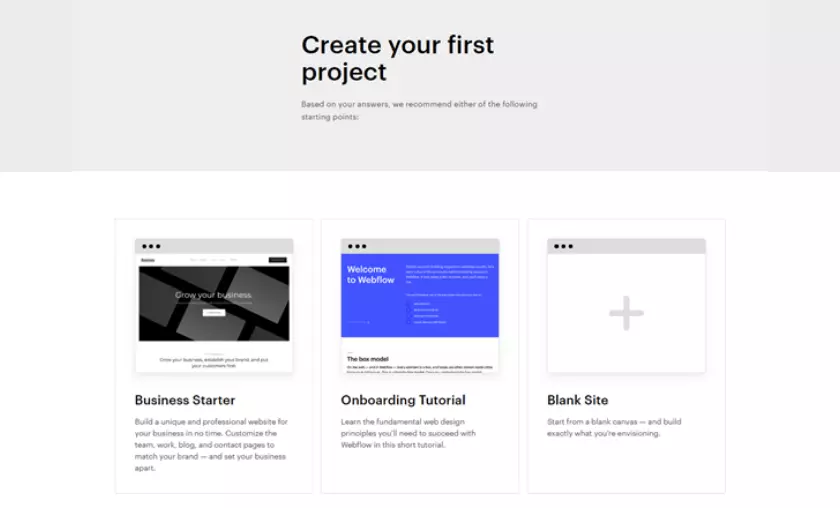
As soon as you sign up for Webflow, the platform does a good job of integration. If you feel confident, you can dive right into the design process, but we recommend the Webflow tutorial for novice users.
Webflow Editor
Once you have completed your tutorial and chosen a template, you will enter the editor. Don’t be alarmed if you think your computer has opened Photoshop by accident: the Webflow editor is very similar.
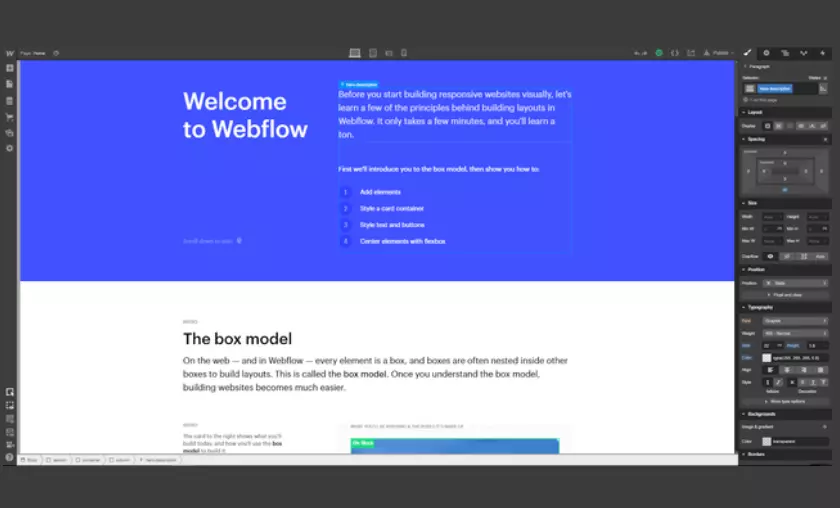
And, just like Photoshop, there are many design options to choose from. While web designers will feel like kids in a candy store, regular people may feel intimidated.
There’s a lot to take in, and even with the starter tutorial, it’s not immediately obvious how to do many things. However, as Webflow itself explains, it’s best to think of your website as a series of boxes.
“Box modeling,” as Webflow calls it, is the process of creating a box for each element of your site and layering them on top of each other. Image boxes, text boxes and button boxes add up to form the layout of your site.
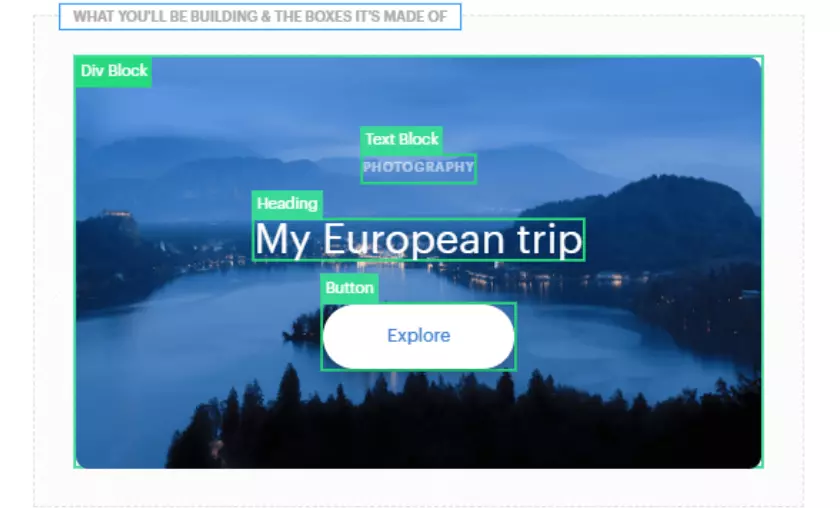
If you think of your website this way, you will find it easier to visualize what you want, but editing can still be complicated. If you are new to creating websites, we recommend that you spend a couple of hours familiarizing yourself with Webflow before you start creating your website.
Template Design
Webflow has over 100 templates in total for you to choose from, including 40 free ones.
You can filter the templates by industry, free/premium or e-commerce. This makes it very easy to find a template that suits your needs. You can even preview the designs before making a decision and see which ones support dynamic content.
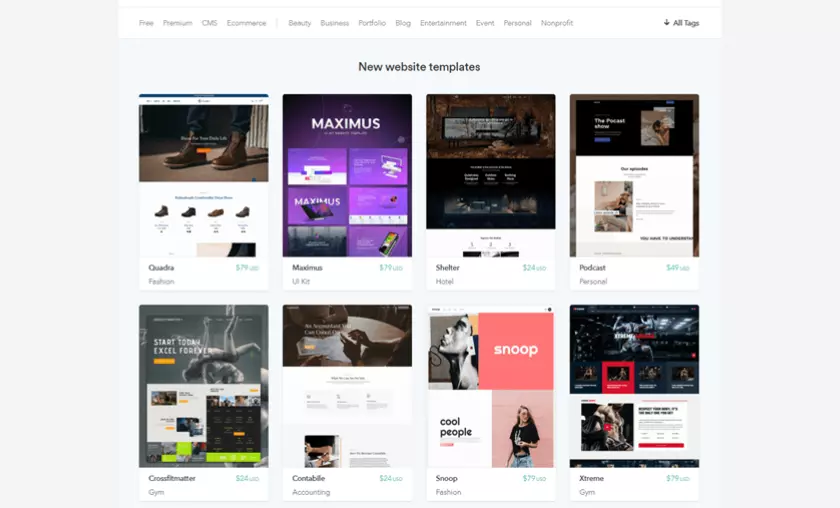
All Webflow templates are responsive, which means that they automatically adapt to different screen sizes, depending on the device your site visitors are browsing with.
In addition, each template comes with a brief description that tells you what type of site it is best for and what your design options are. Most website builders have responsive templates and allow you to preview their designs, but the expanded descriptions of Webflow’s templates are a nice touch.
Premium templates range in price from $19 to $149. Most tend to cost $49 or $79, which may sound expensive, but as a one-time cost, you should view it more as an investment.
Overall, Webflow’s templates are well-crafted and can compete with the market leader, Squarespace, in terms of design quality. They are clean, adaptable and fully customizable.
Features
Features is generally where Webflow falls down compared to other website builders on the market. While the likes of Wix, Weebly and Squarespace have a wide range of features, Webflow’s options are rather frustrating.
Social media integration is a good example. While you can link to Facebook and Twitter pages with ease, embedding a live feed or linking to Instagram proves quite difficult.
It’s worth taking a look at Webflow’s help center, called Webflow University, to see what’s possible and what’s not. This will save you time trying to find a feature that you think should be really simple to locate.
Many of the more advanced things you can do in Webflow are not integrated. Instead, they come as integrations that you can add to your website.

Most major website builders have their own app stores. Webflow integrations are similar, but their plugins are created by third parties, not directly by Webflow.
Let’s take a look at some of the main integrated features that Webflow offers you, whether you are creating a regular website or an online store.
Webflow’s Core Features
On a slightly more boring (but very important) note, security is something that Webflow also takes very seriously. In addition to providing you with automatic backups, so you can restore your site to the last save point in case something goes wrong, it also includes a free SSL certificate. This helps protect your site and shows visitors that your site can be trusted with their personal information.
Search engine optimization (SEO) is the process of modifying a site’s content so that it appears higher in Google and Bing results pages. Most platforms allow you to add/edit metadata, create alternative text for images and target keywords. Webflow goes a step further and offers automatically generated sitemaps and customizable 301 redirects.
Webflow’s Ecommerce Features
In addition to accepting standard credit and debit card payments through Stripe, Webflow also allows you to accept Apple Pay and PayPal.
When a customer arrives at checkout, Webflow automatically calculates the sales tax and VAT due and adds it. This can save you hours of time entering different tax brackets and modifying VAT costs.
Synchronize products with your Facebook and Instagram store. This not only allows you to cross-sell between your website and social channels, but also to run smarter marketing campaigns.
Help & Support
Webflow has some really useful tutorials and guides, but the level of personal support leaves a lot to be desired.
Let’s start with the good stuff. Webflow’s own help center, Webflow University, is an online resource where you can find guides on everything from how to use the platform to how specific integrations work. It’s well laid out, easy to search and, in general, should be the first place you look if you get stuck.

Failing that, you can always go to the Webflow community forum, where users gather to discuss the platform and share their experiences and difficulties. If you need help, I’m sure someone has had the same problem.
But not everything is rosy. If you want to contact Webflow directly, it can be a bit of a hassle. Webflow does not currently offer a phone or live chat service, so the only way to get in touch is by email.
Webflow’s response team is available from 6am to 6pm, Monday through Friday, and you can expect a personal response within 24 to 48 hours. You can leave a message and attach files to show exactly what the problem is.
Pricing
Pricing is another aspect of Webflow that can turn people away: it can be quite expensive!
Since Webflow markets itself as a more sophisticated website builder that offers users more creative control, it’s only natural that its pricing would reflect this. The problem is that the average user may not need, want or know how to use half of the things they are paying for….
Webflow currently has six pricing plans: three for websites and three for online stores.
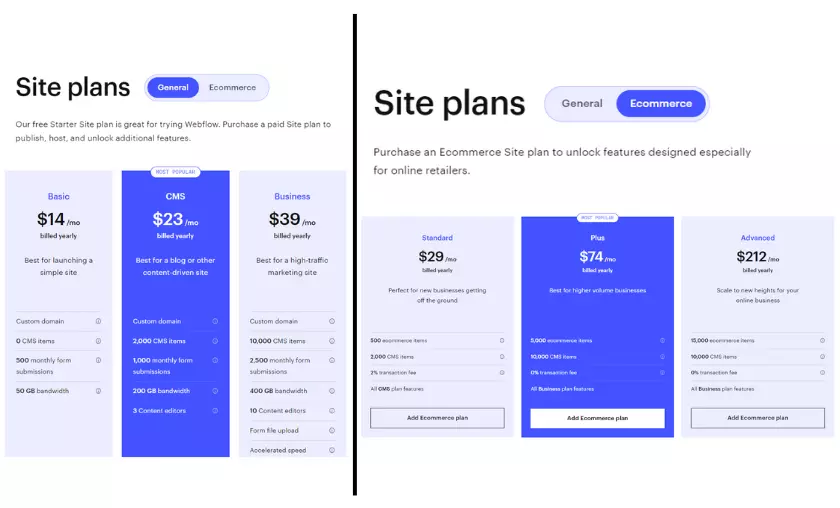
Although you can create a website for free, the lowest price for which you can publish it online is $14 per month with Webflow’s “Basic” plan. It is suitable for simple sites that only need a few standard elements, such as image galleries, contact forms or menus.
The CMS plan focuses on blogs and content-based sites, while the Business plan is, as you might expect, for companies that want to market and expand their business.
Webflow’s e-commerce plans range from selling a few products (Standard plan) to efficient wholesale (Plus plan) to marketing and managing your products to a global audience (Advanced plan).
There is also Webflow for businesses, which is available on a budget-by-budget basis. In this case, Webflow will help you create your site and assist you throughout the process. This is a great service, but it is only suitable for large companies.
Conclusion
So there you have it – a full review of Webflow. As you can see, this is a website builder with a very specific target audience and clear strengths and weaknesses.
Despite not being the cheapest or easiest platform to use, Webflow holds its own when it comes to design. You can customize all sorts of things, without having to know code, which makes it very advanced without feeling inaccessible.
The templates are well-designed, mobile-optimized and cover a wide range of industries. Webflow’s features, however, are quite limited, and you may have to make use of its third-party integrations.

FAQ’s
Is Webflow better than WordPress?
It’s more about choosing the one that best suits you, not that one is better than the other. WordPress is an open source platform where you can create almost anything, but you will need advanced coding skills. Webflow eliminates that need, so it’s definitely the easier choice.
Is Webflow good value for money?
Not really. Webflow is a website builder at the high end of the market, but there are other platforms of similar quality that are much more reasonably priced. Wix, for example, is much cheaper, with prices ranging from $11 to $35/month. Webflow, on the other hand, charges up to $212/month for its top plan.
Do you have to pay for hosting with Webflow?
No. Webflow, como cualquier otro constructor de sitios web, aloja su sitio web por usted. Esto significa que el coste de cosas como el alojamiento web y la seguridad están cubiertos por la cuota mensual.
Si utiliza una plataforma autoalojada como WordPress, tendrá que pagar el alojamiento por separado. Puedes obtener más información sobre los mejores alojamientos web aquí.
Henry Sprung is an e-commerce tech blogger with several years of experience in online retail. Alex’s blog focuses on topics such as online marketplaces, payment processing, and digital marketing for e-commerce businesses. Henry’s expertise in e-commerce provides valuable insights into the latest trends in online retail and how businesses can use these platforms to grow their sales. He is a valuable resource for online retailers and entrepreneurs looking to start their own e-commerce businesses.
To read more similar articles, click here
Thanks for visiting our Website. If you appreciate our work, kindly show us some support in our comments section 🙂


